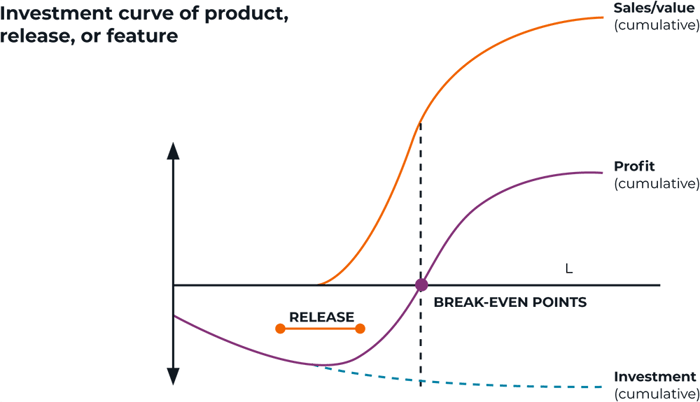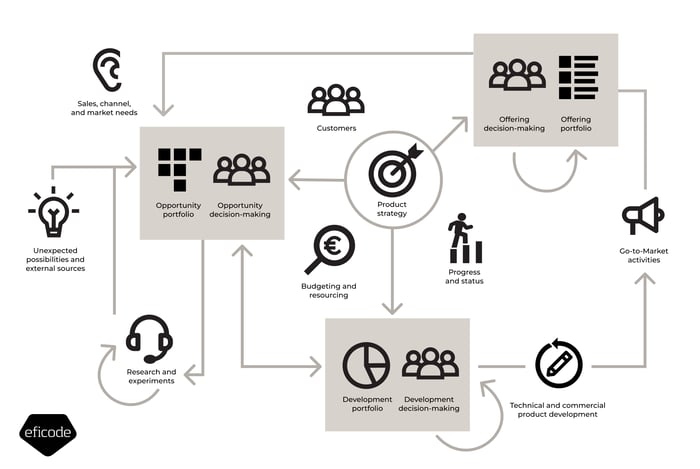The ultimate guide to portfolio management
Master portfolio management and Agile to enable business success

When organizations need to make decisions about future competitiveness, short-term effectiveness, and maximizing value creation of their properties (products, services, data, other IPRs, etc.), they often turn to portfolio management as a solution.
Good portfolio management can enable your organization to adapt to market changes and emerging trends more easily, which is crucial in today's fast-paced business environment. Portfolio management isn’t just about optimizing current assets. It’s also about guiding strategic decisions that can shape your organization's future.
But since portfolio management covers a number of topics, it can often be misinterpreted within various parts of your organization. Not only that but portfolio management today is still discussed on a general level.
Portfolio management doesn’t function in the same way in every business or situation, so your organization must clearly define the management of different portfolios so everyone knows who decides what, where, and when decisions are made (as well as the frequency of decision-making).
Part 1
Understanding portfolio management
Product management vs. portfolio management
When discussing the topic of portfolio management, product management tends to be brought up. So, what is the difference between product management and portfolio management? Product management refers to a business-oriented product or service management, while portfolio management refers to the operating system of product organizations.
The goal of product management is to maximize the benefits and the value your product or product portfolio generates throughout its lifecycle. The easiest way to understand it is to look at the product lifecycle model and think about what kind of measures are needed at each stage. Product management is an ongoing activity, which can also involve discontinuing the old and commercializing new ideas.
Portfolio management, on the other hand, ensures the focus of an organization’s financial and temporal investments on the elements that have the highest potential–creating the framework for leading an efficient product organization and helping data-driven decision-making.
The difference between the two is that product management is about leading a product’s market success (or failure), whereas portfolio management focuses on organization-wide business success.
The benefits of company-specific training
Company-specific training is an effective way to introduce change, as it’s easy to supplement what’s been learned in the training afterward from other sources. When the whole team is trained together, a uniform view of the matter and related terminology is established.
Company-specific training considers business characteristics and context, with participants obtaining key knowledge and understanding how it impacts their roles and the wider business.
The six challenges of well-operating portfolio management
Typically, only certain aspects of an organization's portfolio management receive the attention they need–often leaving other crucial parts overlooked. Addressing these six challenges will help you enhance the effectiveness of portfolio management.

1. Understanding how a product organization's efficiency is formed
The effectiveness of a product organization is determined by its long-term success in the market. But effectiveness is a complex topic influenced by the entire product organization that spans from developers and sales to management and customer service.
To gauge the success of a product, release, or feature, you need to employ an investment curve that shows the relationship between investment, profit, and time. Recognizing how various functions impact investment effectiveness at different points in the timeline is crucial. Success often arises from the collaboration of multiple functions, with effective portfolio management throughout the investment lifecycle being the key to achieving it.
2. Differing views of portfolios and portfolio management concepts
When discussing portfolio management, you must ensure everyone is on the same page. Certain words and definitions in portfolio management can have different meanings for anyone involved. For example, portfolio management might mean the backlog of more significant cases or future ideas and analyzing them for product developers. For anyone in business, portfolio management can mean current products and features, customer projects, or future opportunities.
3. Coordination of diverse steering models
The investment curve (shown previously) demonstrates how different functions impact the success of products and services. In addition to strategy and portfolio management decisions, an organization’s activities are steered by the line organization, personal views, compensation models, and a general understanding of its business model. That said, you shouldn’t build your portfolio management to steer every activity, as this process would be too slow to enable you to take advantage of the organization’s potential and capacities.
Ensure your portfolio management influences the line organization, resource allocation, and bonus and compensation models. Open communication and sharing information about portfolio management decisions are crucial, and defining your portfolio management policies, needs, and solutions are key to improving effectiveness.
4. Inadequate selection of different portfolio managing methods
Some organizations may consider business cases the most crucial part of portfolio management. But this perspective can oversimplify the role portfolio development plays within organizations. While business cases have a place in early investment decisions, they shouldn't be the only tool for portfolio analysis.
One area you should focus on is real-time data during the development status, which can help you better understand customer needs, optimize delivery through automation and quick release cycles, and ensure readiness for release.
Different tools and methods are also needed to optimize return on current products, features, data, or assets. For example, historical data guides future guidelines, and the right tools identify potential improvements, like changes in pricing, marketing, sales campaigns, or lifecycle adjustments.
5. Strategy’s role in prioritizing
Aligning your decisions with strategy is difficult as each strategy level is rarely concrete enough to answer questions about prioritizing. Portfolio management is seen as a solution to this as it enables you to fulfill these goals and is the most important tool in strategy implementation. But strategy only tends to play an active role in some organizations instead of being the crucial driver in all portfolio management decisions it should play.
6. Organization size and regulating your portfolio management
The size and structure of an organization significantly impact its portfolio management at various levels, and achieving alignment in every decision within large organizations is impractical. Instead, focus on aligning as many decisions as possible, facilitating the pursuit of goals even when there's overlap in priorities among staff and teams.
Every business requires organization-wide portfolio management, as well as more localized unit-specific management. To approach shared portfolio management effectively, you should focus on the smallest common limiting resource.
Why do organizations use Jira Align for their portfolio management?
Atlassian’s Jira Align was built to solve the challenge of Agile at scale, which ties in with portfolio management. With it, a product and portfolio manager can have a single platform to manage strategy and report on progress. Additionally, teams working in Jira Align can collaborate in real-time and remove silos along the way.
Check out our guide on better portfolio management decision-making with Jira Align.
Part 2
The three-portfolio model
The core of the three-portfolio model is to understand the opportunity, development, and offering portfolio value creation models, as well as their differences and decision-making needs.

Strategy driving all portfolio decisions
Business success today hinges on smart portfolio management, which involves aligning your projects and products with your big-picture goals. A winning strategy is key: it must be competitive, clear, and actionable.
Think competitive. To lead the market, you will need to have a deep understanding of the dynamics and customer needs and craft a unique value proposition. Your strategy should keep you ahead, focusing on the opportunities that will empower your organization.
Clarity is vital, too. When your strategy is crystal clear, and you keep everyone on the same page, choosing the right projects and allocating resources becomes straightforward–maximizing strategic value.
Actionability is about setting specific, measurable goals that turn lofty ideas into real-world results. A clear roadmap, well-defined milestones, and regular check-ins will transform your strategy into action.
In essence, the connection between strategy and portfolio management is central to your business success. A solid strategy guides your choices, and effective portfolio management brings your goals to life.
Find out how to make your product or service strategy succeed below.
Choose the right tools for your Agile transformation
The creation of value within the organization depends heavily on the tools used, as they affect development and workflow. Inefficient tools can create blockers and make the process more complicated. When an organization begins an Agile transformation, it needs to take its tools into consideration.
Using the same tools you’ve used before for your transformation can be counterproductive as they may not support Agile development appropriately. It’s also important to understand that tools themselves are not sufficient to transform an organization.
Check out our guide on the Forces and Counterforces of business agility for more details.
Opportunity portfolio
The Opportunity portfolio is a strategic tool for smart investment in growth, profitability, and delivering customer value. This portfolio helps you make decisions that are based on the latest, most beneficial sources of information.
Opportunities can be sourced from various places, including:
- Customer feedback, which reveals unmet needs and leads to new or improved products.
- Monitoring market trends keeps us ahead, showcasing new sectors and changing consumer preferences.
- Reviewing current products can show potential for enhancement.
- Technological advances inspire groundbreaking offerings, and legal or socio-economic changes, which sometimes present new opportunities or necessitate product updates.
For your evaluation process, we recommend starting with a business case analysis to assess each idea's financial and strategic impact, followed by conducting small-scale business experiments and market tests. Developing proof of concepts is another crucial step, which shows the feasibility and potential impact of innovations.
The Opportunity portfolio is more than just about ideas. It’s a strategic decision-making tool that demands careful analysis and prioritization–all of which are central to decision-making, identifying potential game-changers, and high-return opportunities.
Learn more about how we unblocked product development for one of our clients using Opportunity portfolio management practices below.
Development portfolio
The Development portfolio plays a key role in enhancing organizational efficiency, fostering business value creation, and prioritizing the success of ongoing releases and projects. It covers decisions related to content, timelines, resources, and business models to unlock its full potential.
While initial ideas about these aspects are included in the decision-making process of the Opportunity portfolio, our understanding of both the technology and market advances over time. Because of this, more refined decisions become crucial during the development phase.
Adopting Agile at scale is a key strategy in our development portfolio to boost product creation efficiency. When scaled, Agile methodologies enable organizations to respond quickly to market changes and customer needs. Overall, this method fosters iterative development, rapid prototyping, and continuous improvement.
Implementing Agile at scale also allows businesses to divide large projects into manageable units, promoting focused and efficient work streams. This not only speeds up the product development cycle but also enhances team collaboration–sparking innovative solutions and faster market entry. Agile at scale connects with strategic portfolio management, ensuring development efforts support the company's strategic goals and maximize Development portfolio value.
Learn more on how to implement Agile right below.
Offering portfolio
The Offering portfolio helps investments focus on key objectives relating to the organization's strategy and future market conditions, with the goal of ensuring the future success of the product or service. Decisions can be adjusted as the volume of information increases, and the prioritization and analysis of ideas and research are also carried out within the Opportunity portfolio.
Go-to-market activities
The success of every release is closely tied to the go-to-market (GTM) strategy, which involves launching the release into the market. GTM activities compete for resources with Development and Offering portfolio efforts, making it crucial to prioritize them at the portfolio decision level. Some organizations manage GTM activities within Development portfolio management, while others incorporate them into the Offering portfolio.
Managing GTM activities effectively is key to ensuring the release gets the best possible start for value creation. These activities come in various forms, from small user notifications and release documents to significant release events and marketing projects.
Resourcing
This is an important aspect of portfolio management, especially when various value potentials require labor or other resources from the same pool to drive value creation. The three-portfolio model doesn't directly address resourcing as it depends on the structure of the organization. To tackle resourcing challenges, two main models are considered:
- A separate synchronized resourcing decision-making model
- Integrating principles of virtual organizations and self-direction.
In the first model, decisions are made on allocating resources to different value potentials, with the idea being that all involved resources will align with portfolio management decisions. Organizations must integrate resourcing as a vital component of their portfolio management to implement decisions and align resourcing with investment prioritizations.
Learn more about the three-portfolio model in our free on-demand webinar series.
Decision-making in the three-portfolio model
Each of the three portfolios listed above has its own distinct goal:
- The Opportunity portfolio focuses on recognizing future value in order to discover market needs we can solve through technological or commercial innovations.
- The Development portfolio is dedicated to maximizing profitable value creation from identified value potentials. Prioritizing projects within the entire Development portfolio is crucial to achieving this goal.
- The Offering portfolio maximizes the organization’s properties: products, features, data, and other IPR profit potential. It’s linked to decision-making regarding marketing, sales, lifecycle, and further development needs.
Larger refinable items and small development needs often arise from the Offering portfolio to the Opportunity portfolio, so your organization needs to agree on its decision-making methods in advance.
| Opportunity | Development | Offering | |
|---|---|---|---|
| Purpose | Value recognition | Value creation | Value creation |
| Goal | To ensure decisions on future investments will be made with appropriate information and analysis tools, to decide on the features, products, technological enablers, experiments, or services to invest in according to strategy in the coming years, and to encourage the discovery of new business opportunities. | To understand the status of cases under development and differences with earlier prognoses, to prioritize decisions on items under development, and to enable releases to reach their post-release business goals from the technology, usability, and sales perspective. | To optimize value creation from completed products, features, and IPR from both commercial and strategic standpoints and to allocate resources for maximum value creation, particularly in sales, marketing, acquisitions, and customer services. |
| Participants | Organization or unit management, business product management, architects, and product development management. | Business, product management, sales, and marketing development personnel. | Organization or unit management and business product management. |
| Issues to be processed | Description of value potential from a business perspective with scenarios or calculations, preliminary plan, projected schedule, and resources, data development plan through experiments, and proposal's relation to strategy. | Overall picture of development resourcing, customer and/or market feedback on projects under development, status of the technological capacity of all projects under development, and estimation and forecast of the progress status of technological and business development. | Historical data on productivity and use of products, services, and other property, estimate of future applicability regarding market development and strategy compliance, and how to maximize value creation potential from current products or property. |
| Possible decisions | Does the opportunity contain enough potential to start investing in developing the suggestion? Despite several uncertainties, does the opportunity contain enough potential to make it worth looking into with experiments and evaluation? What is the proposal's relation to other opportunities in priorities? Should the proposal be rejected for now? | What is the strategic importance of development projects regarding overlapping resources? Prioritization decisions concerning content: Content restructuring, timetable changes, content reduction, or total discontinuation of projects. | Where should we focus the input from marketing, sales, or other external investments? Are there products, features, or other properties needing lifecycle decisions? Are there gaps in the offering portfolio to be bridged with new opportunities? |
The ten building blocks for business agility
Here’s a quick summary of the ten building blocks for practical business agility:
- Create an actionable vision and strategy and empower people to achieve them.
- Create a regular cadence for decision-making at different time spans and make the decisions transparent
- Always state the why of backlog items from the customer's perspective.
- Commit to the most important goals, not timelines.
- Work in the smallest valuable batches and ensure there’s feedback on completed work at every level of the product creation.
- Empower the teams to deliver value to customers.
- Enable continuous dialog about the product’s customer and value throughout the organization.
- Create data from the realized output of items and use the historical data stubbornly for planning.
- Recognize and respect both your internal capabilities and external boundaries, but challenge them regularly.
- Commit to consistently making small improvements at every level. Aim to optimize and simplify.
Part 3
Where to start building the three portfolios
All product or service organizations already have methods and ways to handle portfolio management, and nobody starts theirs from scratch. By starting with an analysis (using the three-portfolio model as an example), you can find out what’s working well and where the most significant shortcomings lie.
Portfolio management is a long, complex process, which means starting as soon as possible is the best approach. While you can always begin drafting a concept for it and planning the process, you’ll find more success in starting the work and adjusting the process and methods as you go.
Here are five points you should be aware of to help you prepare:
1. Management and other steering group participation in portfolio management
Portfolio management is crucial for an organization's decision-making process and attracts the interest of many individuals. That’s why it’s important to assemble a group with optimal decision-making authority and capabilities.
If you attempt to introduce alternative methods for directing investment priorities beyond portfolio management, it will undermine the motivation and credibility of the portfolio management process.
2. Portfolio management decision-making points
In larger organizations, determining the appropriate level of portfolio management and its multilevel structure must be taken into consideration–there is no one-size-fits-all solution to this question. That’s why it’s beneficial to assess this in the context of prioritizing critical resources. If a single group, whether focused on product development, marketing, or sales, oversees all portfolio development and value creation, a singular portfolio management approach may suffice.
But if resources are allocated across business units, each unit should establish its own portfolio management. Establishing an organization-wide opportunity portfolio helps prevent organizational silos from hindering the pursuit of future opportunities, meaning it’s vital to maintain the agility of portfolio management decision-making and avoid overwhelming it with an excessive workload.
Read more about the driving forces of agility below.
3. Portfolio management control cycle
To ensure your portfolio management is effective, it’s essential to comprehend and articulate the frequency of decision-making, which involves understanding how often decisions will be made and how they align with other decision-making points within the organization. Consideration should be given to various factors such as product development sprints, releases, and any other relevant timetables when planning the frequency of portfolio management.
For clarity and insight, you should outline different decision-making point schedules and their interrelations over a three-month period, for example. This approach will give you a better understanding of decision interdependencies and coverage.
In the control cycle, it’s important to consider the required speed of decision-making in alignment with the needs of both business and product development. Delays in decision-making contribute to organizational inefficiencies and should be avoided through all available means.
Learn more about maximizing the business value of product development below.
4. Portfolio management responsibilities and liberties
One of the most challenging aspects of portfolio management lies in the ability to confidently say "no." More often than not, the desire to say "yes" tends to prevail in organizational decision-making. The effectiveness of portfolio management is enhanced when each portfolio has a clearly defined owner responsible for making the final decision (if not achieved through other means). That’s why it’s beneficial to involve representatives from the most crucial stakeholders in portfolio decisions.
As knowledge builds up, portfolio management transforms into a dynamic process involving interaction, reflection from various viewpoints, and the prioritization of issues. It goes beyond the difference between "yes" or "no" decisions on individual needs. Decision-making isn’t a democratic process, and it’s important to identify individuals with the authority to make the decisive call of "yes" or "no" when required.
5. Portfolio management to enterprise tools
Integrating portfolio management into enterprise planning tools is essential, as portfolio management is a complex, multifaceted process that requires real-time data analysis, cross-functional collaboration, and strategic alignment.
Enterprise planning tools (Jira, Confluence, Jira Align, etc.) offer advanced functionalities that are indispensable for effective portfolio management. They provide automated data processing, sophisticated analytics, and seamless integration with other business systems. Using tools like Jira, teams can manage projects with agility, tracking tasks and progress in real-time. Confluence serves as a collaborative workspace, facilitating the sharing of ideas and information across teams. Jira Align connects these functionalities at a higher level, aligning team activities with the company’s strategic goals.
The adoption of integrated tools like this enables organizations to make more informed and strategic decisions, allowing for real-time tracking against goals and swift adaptation to changing market conditions. Additionally, these tools offer a holistic view of the portfolio, ensuring a balanced approach to resource allocation, risk management, and strategic priorities, aligning them with the organization’s overall objectives.
Adopting proper tools is a fundamental step for businesses aiming to achieve high-level strategic execution and maintain a competitive edge in today's dynamic business environment.

Part 4
Unlocking agility with portfolio management
Will the three-portfolio model suit an Agile development organization?
Agile development and portfolio management
When working on managing portfolios, you may be wondering if it's too overwhelming or if Agile development alone can handle all the challenges these portfolios bring. To answer this, start by asking yourself two simple questions:
- What's the goal of Agile development
- What is it designed to do?
The three-portfolio model is built on these ideas. Agile development is about speeding up learning to create the most value and gaining knowledge to make smart decisions that guide value creation quickly.
The three-portfolio model shares the same goal: focusing on learning from value potential as early as possible. An important lesson learned from development is that fixing mistakes early is cheaper and more productive–which the three-portfolio model takes to an organizational level.
Agile development also covers self-direction, autonomous teams, and product owners having authority like CEOs. However, these ideas are hard to implement in larger organizations as decisions can't be made on a team level for the whole organization. Instead, each team makes decisions based on its own situation, delivering quality results for its customers.
The three-portfolio model brings Agile principles to a higher organizational level, aiming to provide agility in investments and prioritization across the entire organization's future market. This way, it combines Agile ideas with decision-making on a larger scale.
Read up on the 10 building blocks every Agile organization needs.

Organizations need true agility instead of Agile practices for business
For the best Agile business practices to be utilized by an organization, they need to provide a competitive advantage that aligns with the goal of business success. This applies to agility too, which requires a deep understanding of how it contributes to that success.
Achieving true agility involves embracing the unpredictable nature of the business landscape and recognizing that while plans are essential, they can be inherently flawed. Simply adopting Agile practice guides isn’t enough; true agility requires organizations to adapt continuously to the evolving external environment.
Check out our guide on the Forces and Counterforces of business agility for more details.
Increase an organization's productivity
Portfolio management is a key part of an organization's decision-making, and the secret to boosting productivity and effectiveness can also be found here. Calculating the returns for projects that improve the organization is tricky, but you can estimate them for conversion projects using the multiplier effect.
The multiplier effect of portfolio management is stronger than almost any other change and acts as the backbone of the organization, which is essential for any product or service setup to function. Business success requires balanced investments in three portfolios, each contributing differently over time.
The three-portfolio model is about understanding the value creation models of Opportunity, Development, and Offering portfolios, knowing their differences, and understanding their decision-making needs.
Opportunity portfolio
- Focuses on investing in crucial objectives related to the organization's strategy and future market situation.
Development portfolio
- Enhances efficiency, ensuring value creation on a business basis.
Offering portfolio
- Maximizes value from an organization's assets by refining, marketing, branding, and adjusting products as needed.
All three portfolios play vital roles in the success of product and service organizations, making it worthwhile to invest in their development and management.


